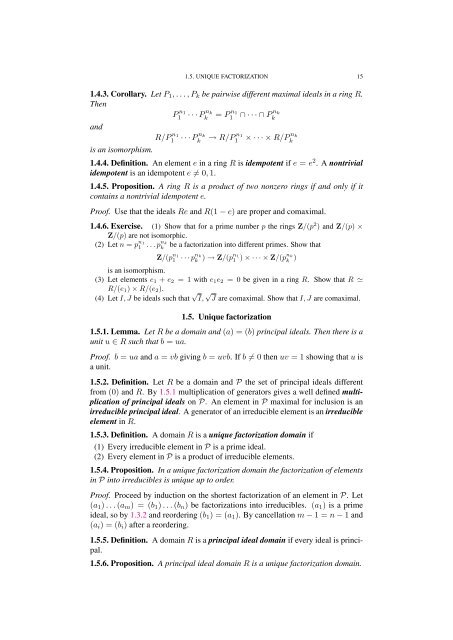Commutative algebra - Department of Mathematical Sciences - old ...
Commutative algebra - Department of Mathematical Sciences - old ...
Commutative algebra - Department of Mathematical Sciences - old ...
Create successful ePaper yourself
Turn your PDF publications into a flip-book with our unique Google optimized e-Paper software.
1.5. UNIQUE FACTORIZATION 15<br />
1.4.3. Corollary. Let P1, . . . , Pk be pairwise different maximal ideals in a ring R.<br />
Then<br />
and<br />
P n1<br />
1 · · · P nk n1<br />
nk<br />
k = P1 ∩ · · · ∩ Pk R/P n1<br />
1 · · · P nk<br />
n1<br />
nk<br />
k → R/P1 × · · · × R/Pk is an isomorphism.<br />
1.4.4. Definition. An element e in a ring R is idempotent if e = e 2 . A nontrivial<br />
idempotent is an idempotent e = 0, 1.<br />
1.4.5. Proposition. A ring R is a product <strong>of</strong> two nonzero rings if and only if it<br />
contains a nontrivial idempotent e.<br />
Pro<strong>of</strong>. Use that the ideals Re and R(1 − e) are proper and comaximal.<br />
1.4.6. Exercise. (1) Show that for a prime number p the rings Z/(p2 ) and Z/(p) ×<br />
Z/(p) are not isomorphic.<br />
(2) Let n = p n1<br />
1 be a factorization into different primes. Show that<br />
. . . pnk<br />
k<br />
Z/(p n1<br />
1<br />
· · · pnk<br />
k<br />
) → Z/(pn1 1 ) × · · · × Z/(pnk k )<br />
is an isomorphism.<br />
(3) Let elements e1 + e2 = 1 with e1e2 = 0 be given in a ring R. Show that R <br />
R/(e1) × R/(e2).<br />
(4) Let I, J be ideals such that √ I, √ J are comaximal. Show that I, J are comaximal.<br />
1.5. Unique factorization<br />
1.5.1. Lemma. Let R be a domain and (a) = (b) principal ideals. Then there is a<br />
unit u ∈ R such that b = ua.<br />
Pro<strong>of</strong>. b = ua and a = vb giving b = uvb. If b = 0 then uv = 1 showing that u is<br />
a unit.<br />
1.5.2. Definition. Let R be a domain and P the set <strong>of</strong> principal ideals different<br />
from (0) and R. By 1.5.1 multiplication <strong>of</strong> generators gives a well defined multiplication<br />
<strong>of</strong> principal ideals on P. An element in P maximal for inclusion is an<br />
irreducible principal ideal. A generator <strong>of</strong> an irreducible element is an irreducible<br />
element in R.<br />
1.5.3. Definition. A domain R is a unique factorization domain if<br />
(1) Every irreducible element in P is a prime ideal.<br />
(2) Every element in P is a product <strong>of</strong> irreducible elements.<br />
1.5.4. Proposition. In a unique factorization domain the factorization <strong>of</strong> elements<br />
in P into irreducibles is unique up to order.<br />
Pro<strong>of</strong>. Proceed by induction on the shortest factorization <strong>of</strong> an element in P. Let<br />
(a1) . . . (am) = (b1) . . . (bn) be factorizations into irreducibles. (a1) is a prime<br />
ideal, so by 1.3.2 and reordering (b1) = (a1). By cancellation m − 1 = n − 1 and<br />
(ai) = (bi) after a reordering.<br />
1.5.5. Definition. A domain R is a principal ideal domain if every ideal is principal.<br />
1.5.6. Proposition. A principal ideal domain R is a unique factorization domain.
















